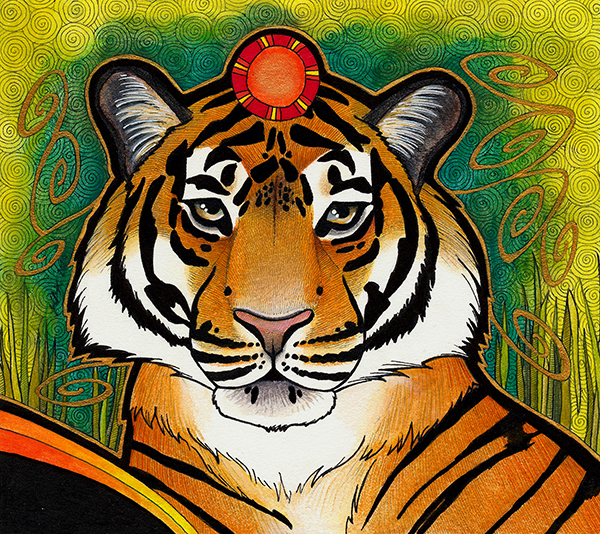Bengal Tiger – Power and Charisma 
Keywords:
Power. Charisma. Attraction. Confidence. Ruling over one’s domain. Maintain your boundaries. Willpower. Courage. Taking time to learn. Monitor your anger and aggression. Forest wisdom. How do you feel about your biggest emotions? What are you hiding from? Unpredictability. Majesty. Self-pride and self-worth. Confrontation.
Description:
The Bengal tiger (also known as the Royal Bengal tiger) – Panthera tigris tigris – is an Endangered subspecies of tiger native to India, Bangladesh, Nepal and Bhutan. They are one of the biggest large cats in the world, and widely recognised for the charismatic, powerful apex predators that they are. They are obligate carnivores. They inhabit many types of forest (moist evergreen, tropical, tropical dry forest, subtropical, temperate upland, moist deciduous forest etc.) as well as mangroves and grasslands. They are attracted to habitats where their preferred prey – ungulates (such as many species of deer, as well as buffalo, boar, porcupines, hares and peafowl) – are found in high number. There are fewer than 2600-3,300 wild Bengal tigers in the world as of 2018.
Males are larger than females, and tigers have the largest and longest teeth of any cat in the world. Adults rarely come together and fighting between the species can be particularly vicious. When food it plentiful, however, sometimes Bengal tigers will congregate. Otherwise the known social unit is a mother with her offspring. Males are usually solitary. All Bengal tigers maintain home ranges that ideally includes water, prey and shelter. While maintaining range boundary, they encounter other adults, which assists with locating mates. Some adults may even tolerate transient tigers in their territory, though this is usually temporary. Infanticide of tiger litters is quite common. Bengal tigers do not tend to leave their mothers until they are around 2-3 years old, at which point they become transient, while looking for their own territory.
Bengal tigers are known to kill predators on occasion, such as leopards, wolves, jackals, foxes, crocodiles, and bears. On extremely rare occasions, they may kill elephants, but this is unusual. They have a ‘feast or famine’ style of feeding due to their hunting methods, eating huge amounts of meat, followed by many days of fasting.
Bengal tigers are increasingly poaching human livestock, due to constant human encroachment on their territories. At times like this they will sometimes attack, kill and eat humans. Their greatest threats include habitat destruction, poaching (for fur, meat, and use as ‘alternative medicine’), and human-tiger conflict. Despite this, they are a beloved and charismatic animal, and there are many conservation efforts underway throughout the world. It is the national animal of India.